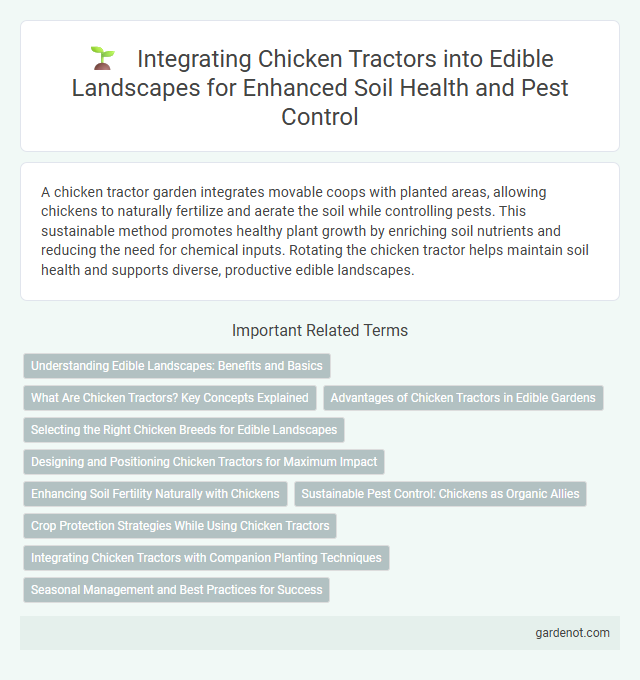A chicken tractor garden integrates movable coops with planted areas, allowing chickens to naturally fertilize and aerate the soil while controlling pests. This sustainable method promotes healthy plant growth by enriching soil nutrients and reducing the need for chemical inputs. Rotating the chicken tractor helps maintain soil health and supports diverse, productive edible landscapes.
Understanding Edible Landscapes: Benefits and Basics
Chicken tractor gardens integrate poultry into edible landscapes, enhancing soil fertility through natural manure distribution and pest control by consuming insects. This sustainable practice promotes nutrient cycling and supports organic garden health while providing fresh eggs and meat. Understanding the symbiotic relationship between chickens and plants is key to maximizing garden productivity and ecological balance.
What Are Chicken Tractors? Key Concepts Explained
Chicken tractors are movable chicken coops designed to allow chickens to graze on fresh ground while providing shelter and protection from predators. These enclosures promote natural foraging, soil fertilization, and pest control, enhancing garden health and productivity. By rotating chicken tractors across an edible landscape, gardeners create a sustainable system that integrates poultry management with organic soil enrichment.
Advantages of Chicken Tractors in Edible Gardens
Chicken tractors enhance edible gardens by naturally fertilizing the soil with nutrient-rich manure, boosting plant growth and soil health. Their movable design allows chickens to control pests and weeds without damaging garden beds, reducing the need for chemical interventions. This sustainable integration promotes biodiversity and improves garden productivity while providing healthy, free-range eggs.
Selecting the Right Chicken Breeds for Edible Landscapes
Choosing the right chicken breeds for edible landscapes enhances soil fertility and pest control while ensuring compatibility with the garden ecosystem. Heritage breeds like Rhode Island Reds, Orpingtons, and Australorps excel in foraging, are hardy, and contribute to natural pest management. Selecting breeds with gentle temperaments and moderate egg production supports sustainable garden integration and maximizes the benefits of a chicken tractor system.
Designing and Positioning Chicken Tractors for Maximum Impact
Designing and positioning chicken tractors strategically enhances soil health and pest control within edible landscapes by allowing chickens to forage specific garden zones without damaging crops. Optimal placement considers sun exposure, wind patterns, and proximity to plants needing natural fertilization, ensuring chickens aerate and enrich the soil effectively while promoting plant growth. Rotating chicken tractors regularly prevents overgrazing and supports sustainable garden productivity through nutrient cycling and integrated pest management.
Enhancing Soil Fertility Naturally with Chickens
Chicken tractor gardens enhance soil fertility naturally by allowing chickens to forage and scratch through the soil, accelerating organic matter breakdown and nutrient cycling. Their manure acts as a rich source of nitrogen, phosphorus, and potassium, vital for plant growth, improving soil structure and microbial activity. This sustainable practice reduces the need for synthetic fertilizers while promoting a healthy, nutrient-dense edible landscape.
Sustainable Pest Control: Chickens as Organic Allies
Chickens in a tractor garden serve as effective agents for sustainable pest control by naturally reducing insect populations without harmful chemicals. Their foraging behavior targets pests such as beetles, larvae, and larvae eggs, promoting a healthier garden ecosystem. Integrating chickens into edible landscapes enhances soil fertility through nutrient-rich manure while maintaining organic pest management practices.
Crop Protection Strategies While Using Chicken Tractors
Chicken tractors offer natural pest control by allowing chickens to forage and eat insects, reducing the need for chemical pesticides. Protective measures include rotating chicken tractors regularly to prevent soil depletion and minimize plant damage while promoting even nutrient distribution. Incorporating barriers such as lightweight fencing helps safeguard young or vulnerable crops from excessive scratching and trampling by chickens.
Integrating Chicken Tractors with Companion Planting Techniques
Integrating chicken tractors with companion planting techniques enhances soil fertility and pest control by combining free-range poultry with mutually beneficial plant species. Chickens naturally till the soil, providing nutrient-rich manure that supports the growth of companion plants such as herbs, vegetables, and flowers, which in turn attract beneficial insects and deter pests. This sustainable synergy maximizes garden productivity while promoting ecological balance in edible landscapes.
Seasonal Management and Best Practices for Success
Seasonal management of a chicken tractor garden requires rotating the tractor across different plots to prevent soil depletion and control pests. Best practices include providing adequate shade and fresh water during hot months, while offering insulated shelter and access to unfrozen water in winter. Monitoring chicken behavior and adjusting forage availability helps maintain soil health and optimize crop growth throughout each season.
Chicken tractor garden Infographic

 gardenot.com
gardenot.com